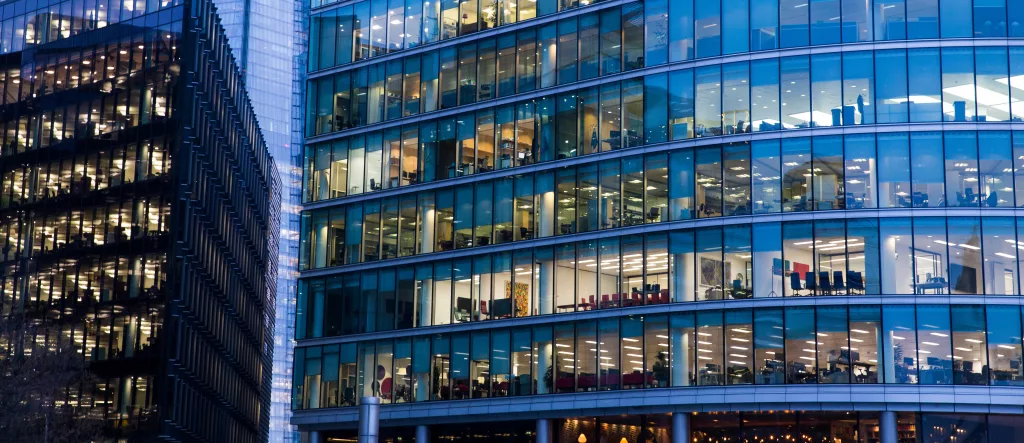A new report shows employers are investing in more office space, better office space, and designs that put employees first.
A new report released by real estate giant CBRE indicates that we may finally be turning the corner from the pandemic as more employers look to expand their office space holdings and invest in amenities and designs to make hybrid work the most effective it can be for employees.
As many as 38% of the 225 companies surveyed in the 2024 Americas Office Occupier Sentiment survey said they planned to expand their real estate portfolio, compared to 20% last year. This focus on growth is a stark contrast to the past three-plus years, during which many more companies were focused on contracting their real estate holdings and had struggled to adapt to the uncertainties around the new hybrid workplace.
“I’m not saying that it has 100% shifted, but it has shifted more in the favor of expansion this year,” says Julie Whelan, global head of occupier thought leadership at CBRE, a commercial real estate services and investment firm.

Small companies are driving this expansion
Smaller and mid-size companies are driving this trend. There is a greater share of office leases being transacted for properties smaller than 20,000 square feet than before the pandemic. Many of those businesses may have gotten rid of their space entirely back in 2020, and now they’re coming back to the office, Whelan says.
Add to that: more small businesses are being launched today. Since 2020, an average of 4.7 million new businesses have been started each year, according to the U.S. Census Bureau. In 2023, a record-breaking 5.48 million new businesses launched.
Meanwhile more than half of larger companies, which may have millions and millions of square feet of office space in their portfolios, are still in a contraction phase. Those planning to reduce their portfolio requirements dropped to 37% from 53% last year. At least 25% expect their portfolios to stay the same, according to CBRE.
Certainty is driving expansion.
Whelan says employers today have more certainty around hybrid work behaviors than they did four years ago. Sixty-four percent of companies report office attendance is at a steady state, up modestly from 60% in 2023 and 43% in 2022. The average hybrid schedule tends to be around three days a week in the office. And employers are buoyed by more certainty in the economy, which previously had prevented many from executing on longer-term portfolio strategies, says Whelan.
Offices have more people than seats.
Seat sharing has been something that people talked about prior to the pandemic. But it never really took off, until now. Office occupancy rates are above 100%, which means that offices have more people than seats. “That was a huge finding for us,” says Whelan. This is the first time CBRE has seen this in the portfolios that it tracks, she says.
People have enjoyed having their own desks and their own spaces to decorate and call their own, but now they’re beginning to realize that if they come to the office just two to three days a week, sharing a desk is a trade-off for flexibility, Whelan says.

Demand for Better Offices
Employers are also flocking to higher quality office space. As many as 59% of companies are relocating because they want to upgrade an office space for a better location, better quality space or an improved employee experience.
CBRE has found that prime space makes up about 10% of the market, and those properties now have low vacancies and are highly competitive and sought-after by employers. “Most of the market today is older stock that’s not in a great location or hasn’t had new capital to bring it to a new standard,” Whelan says.
As many as 90% of companies surveyed by CBRE said that food and beverage options were a top amenity, while 87% said access to public transportation, 85% said car parking and 72% said sustainable building features.
Shifting Workspace Design
The design of office space is also changing. Organizations are not necessarily making wholesale transformations of their spaces, because of the high cost, needed vision and cumbersome buy-in required.
But they are making targeted investments in changing what their office looks like, and that usually comes in the form of more collaboration space and more amenity spaces to meet and socialize and hold video calls in, says Whelan. They’re paying attention to private spaces, too.
At least 44% of companies are increasing their “we space,” or collaborative workspaces inside offices since the vast majority of employees head into an office because they want connection with their colleagues. At least 50% are increasing the amenities they offer employees, and as many as 86% of companies plan to increase their space sharing.
Companies are keeping “me space,” or those private workspaces for focus work and private conversations. “It remains important,” she says.
The Pursuit of Office Happiness
Employers are increasingly using room-booking software, occupancy tracking software, various engagement surveys and occupancy data to better judge how happy, productive and engaged employees feel when they’re at the office.
Cushman & Wakefield is leading this charge, trying to assess “employee experience per square foot” (XSF) with software that measures what matters to employees at each individual company and at each individual location. Other designers are hiring experts to look deeply at human behavior to uncover how a space and design impact psychology, emotions, focus and group dynamics.
But measuring productivity among knowledge workers is tricky. Whelan says it will require ensuring employee and company goals are tied to being in the office, tied to what a worker’s purpose is there, and tied to how the office helps them achieve those goals. “I don’t think most organizations have cracked that nut,” she says.
We may have gotten past the questioning about what the new hybrid world would look like and early skepticism about whether an organization even needed an office. Employers recognize the value of an office. The next challenge will be to ensure those spaces are effective.
